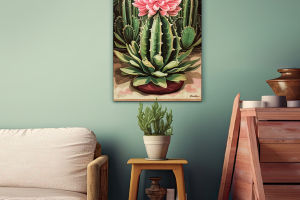Let's take a moment to think about this—every breath we take is part of a cycle that includes the green plants around us.
Whether it's a tiny potted plant by the window or a vast forest, green plants are constantly working behind the scenes to evolve the air we breathe. But how exactly does this happen? Let's uncover this green magic together.
Photosynthesis: The Foundation of Air Evolution
At the heart of this transformation is photosynthesis. This process allows green plants to absorb sunlight and use it to convert carbon dioxide and water into glucose and oxygen. For us, the most important part is the oxygen they release. We breathe it in, and in return, we exhale carbon dioxide, which plants use again—a perfect, natural exchange.
This process not only provides the oxygen we need but also helps reduce the carbon dioxide in the air. With rising global emissions, this natural balance is more important than ever.
More Than Oxygen: How Plants Regulate Humidity
But green plants do more than produce oxygen. Through a process called transpiration, plants release moisture into the air through small pores on their leaves. This helps regulate indoor humidity, making the air feel fresher and more comfortable—especially in dry climates or air-conditioned spaces.
A group of healthy plants can act like a natural humidifier, which is especially helpful during winter when indoor air tends to become dry.
Plants Absorb Pollutants—Here's How
Plants don't just give—they also take. Many common indoor pollutants such as formaldehyde, benzene, and xylene can be absorbed by plant leaves and roots. These harmful chemicals are often released from furniture, paints, and cleaning products. Green plants can absorb these pollutants through their stomata and neutralize them using natural metabolic processes.
Some species even have roots that partner with beneficial microorganisms in the soil. Together, they break down pollutants and reduce their concentration in the air. It's like a quiet air-cleaning system right under our noses.
The Leaf Area and Species Matter
Not all green plants evolve the air equally. Some species are especially good at purifying air, while others are more decorative. Plants with large, broad leaves—such as rubber plants or fiddle-leaf figs—have more surface area to absorb pollutants and release oxygen.
Popular air-purifying plants include:
- Peace Lily – Absorbs ammonia and benzene
- Areca Palm – Adds humidity and removes toxins
- Snake Plant – Releases oxygen even at night
Plants and Climate: A Global Air Impact
Beyond our homes, green plants—especially trees and forests—have a massive role in the Earth's climate. Rainforests are often called the "lungs of the planet" because they produce huge amounts of oxygen and store massive quantities of carbon dioxide.
When forests are cut down, we lose not only green cover but also this essential function of air evolution. That's why planting trees and protecting green spaces is one of the most powerful actions we can take for cleaner air and a healthier climate.
How We Can Make the Most of It
We can support the air-evolving power of plants by:
- Keeping several healthy plants indoors
- Choosing plants with proven air-purifying ability
- Avoiding overwatering to prevent root rot
- Ensuring they receive enough sunlight and air circulation
- Supporting reforestation efforts in our communities
With just a few green friends, we can make a real difference in our homes—and beyond.
Let's Grow Clean Air Together!
So Lykkers, every time we care for a plant or enjoy a stroll outside, let's remind ourselves that we belong to a living ecosystem. Green plants do much more than decorate—they actively improve our air and quietly support our well-being every day.
Let's nurture more greenery around us, from a single pot on the windowsill to the trees in our neighborhood. What plants brighten up your space? Share your favorites with us, and together we can create a fresher, healthier world—one leaf at a time.


